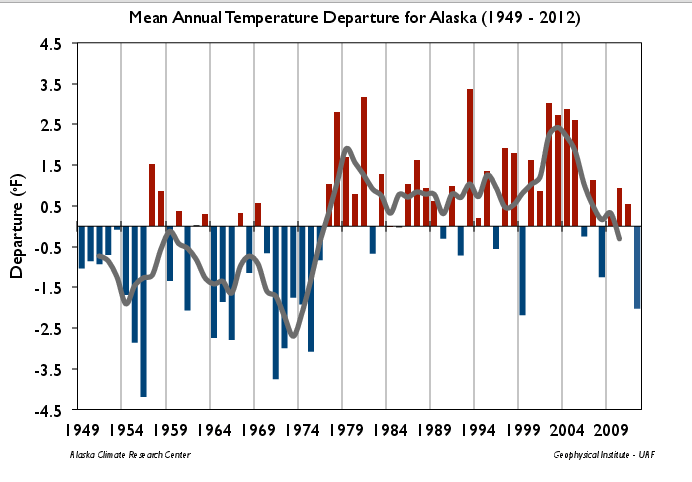6. Alaska is becoming unrecognizable.
Nowhere is global warming more stark than in our only Arctic state. Temperatures there have increased much more than the national average: 3 degrees Fahrenheit since 1949, or “double the rest of the country.” The state has the United States’ biggest and most dramatic glaciers—and it is losing them rapidly. Meanwhile, storms batter coasts that used to be insulated by now-vanished sea ice.
7 Scary Facts About How Global Warming Is Scorching the United States | Mother Jones
Every word of the above is utter BS. All of the warming in Alaska occurred in 1977, when the PDO shifted. Over the last decade, Alaska temperatures have plummeted. 2013 was one of the 10 coldest years on record in Alaska.
Last year the Tanana River had its latest breakup on record. The Bering Sea had the most ice ever recorded two years ago. And the Muir Glacier receded eight feet per day from the 1790s to the mid-18th century.
As usual, every single global warming “fact” is a gross distortion.



Last summer I was taking the Alaska ferry south past Juno, the state capital. Hanging above the town is a very ominous looking glacier. If all this “global warming” gets much worse Juno could be wiped off the map, and so could several other Alaska cities.
With the internet and a computer it is now easy to see the LIES/ propaganda put out by the government.
Interior Alaska shivers in record cold temps
April 29, 2013
FAIRBANKS — The winter that won’t end continued Sunday with record-low temperatures around Interior Alaska.
The low temperature at Fairbanks International Airport was 2 degrees above zero, which obliterated the old record of 8 above set in 1924. New records were set at Eagle (5 below), Eielson Air Force Base (1 above) and Delta Junction (3 above)….
The chilly temperatures are the product of cold, dry air from the North Pole and Arctic Ocean being blown over a large part of Alaska. Temperatures are not expected to warm up dramatically anytime soon, Keller said….
The normal low temperature for April 28 in Fairbanks is 30 above and Sunday’s high temperature of 37 barely topped that. The normal high is 53 degrees….
Another article from a couple years ago talked about the snow not melting in the mountains around Anchoragel even though it was August. FOUND IT! see: August 4, 2012 Alaska’s mountain snow refusing to melt this summer “Mountain ranges surrounding Alaska’s largest city are still dealing with last winter’s snow, says this article on accuweather.com. Last winter’s all-time record snowfall of 133.6 inches could give Anchorage an endless winter.
It’s unusual to see snow still remaining in some of the mountains that surround Anchorage, said United States Department of Agriculture Snow Survey Supervisor Rick McClure.”
And an eyewittness report:
Ice Age Now has a listing of articles detailing the real state of Alaska’s weather HERE
What’s funny is the cable shows Yukon Men, based in Tanana, and Deadliest Catch, in the Bering Sea, both have shown extremely cold, bad winters the last few years.
The owners of the Time Bandit were so freaked by how bad the ice was maybe 2 seasons ago, they clad the entire front of their boat with another 3/8 inch of plate steel in the off season, to get a full inch of steel. They certainly didn’t spend all that money because the ice is getting thinner.
On Yukon Men, not only did they mention it was the worst winter in decades, but they repeatedly had certain hunting seasons that were abnormal. Either the animals didn’t show up because they moved to a different area, or the season was extremely short. Also caused them other problems like having to burn more wood than normal to keep the city’s water supply going. They also had to literally move buildings and everything else they could to high ground due to the flood caused by a late ice breakup.
Anyone watching those has to know that things aren’t getting warmer in Alaska.